To help us provide you with free impartial advice, we may earn a commission if you buy through links on our site. Learn more





- Well-made bike with excellent ride feel
- Simple to set up
- Good range of classes
- Adjusting resistance can be fiddly
- No virtual rides yet
Save 25% on the Apex Rides spinning exercise bike
When we reviewed the Apex Bike back in the midst of the second lockdown we were impressed with its combination of affordability, effectiveness, and build quality. Now, this homegrown, UK-based Peloton rival is on offer with 25% off the regular price, bringing the initial cost down from £1,200 to £900. Remember, though, you'll also need to pay extra per month for online classes to make the most of it.
£900
John Lewis
The year 2020 is one most of us will want to forget but, for manufacturers and retailers of home exercise equipment, it’s been busier than ever. As gyms have closed, opened and then closed again, people desperate to get their fitness fix have turned to treadmills, exercise bikes and rowing machines.
The new Apex Bike aims to take advantage of this new wave of interest in home fitness, but it’s much more than a straight exercise bike: like popular rival Peloton, it aims to bring the experience of studio-based exercise-bike classes into the comfort of your own home.
READ NEXT: The best exercise bikes to buy
Apex Bike review: What do you get for the money?
The Apex Bike itself costs £1,200 and it’s a well-made item. It’s streamlined and sleek, its road bike-style saddle and narrow, multi-position “aero” handlebars mean it’s comfortable to ride, and it looks great too. It’s available in four different colours – black, light grey, dark blue and “Nude” – so you can match it with your decor if you’re bothered about that kind of thing.
It’s simple to quickly adjust to your own riding position, with easy pull and slide height adjustment on the saddle and bars, and you can tweak the saddle fore and aft as well to get the perfect position on the bike. It even comes with 50/50 SPD pedals so you can either clip in with your favourite cycling shoes or spin them around and strap yourself in with just a pair of trainers.
Resistance is supplied by a 4kg flywheel at the rear – this may not seem like much, but there’s plenty of resistance for most riders. I was barely able to turn the pedals with the resistance dialled right up to the max and it’s very quiet when you’re pedaling at full tilt.





The bike doesn’t have a built-in display, as provided with a Peloton or Echelon bike; instead, you mount an iPad on the integrated tablet holder at the front, or use your phone and cast the classes to your TV. To keep your devices topped up, there’s a pair of USB-A outputs at the front of the bike and a wireless charging cradle for your phone.
Apex, however, is about far more than just the machinery. Just like the more famous Peloton system, it’s all about bringing the motivation of the fitness studio into your home. Paired with the Apex Rides app on your phone or tablet (currently only compatible with iOS devices) and a £30-per-month subscription, you get unlimited access for up to six people in your household to a series of virtual exercise-bike classes, all put together by the instructors at London-based studio Boom Cycle.
That might sound pricey, but for a smart exercise bike like this it’s actually pretty reasonable. The Peloton bike is much far more expensive, costing £1,750 for the basic bike and £40 per month after that for the all-access subscription.
At the moment, there isn’t the range of sessions available from Apex as there is on Peloton, but that’s understandable given the young age of the system. And bear in mind that this will expand as the system develops. Apex says it’s developing a free ride system for those times when you want something a little different, and live classes are set to start in February.
At the time of writing, there are 150 on-demand sessions available from ten instructors and these run the gamut from 15-minute warm-ups to hour-long leg burners. They cover four levels of difficulty and, as well as straight biking classes, there are sessions that include work with weights, for which there’s a pair of storage hooks beneath the saddle, and off-bike HIIT sessions as well. To make it easier to find the class you’re looking for, you can filter by level, instructor, length, music genre and content (“move” or “metric”).
READ NEXT: The best exercise bikes to buy
Apex Bike review: What are the classes like?
Apex’s classes are what you’d expect from a top-level studio such as Boom Cycle. They’re slick, the instructors know what they’re doing and production levels are high. Depending on how loud you have the music pumping and how big your screen is, they can be pretty immersive too.
During each class, you’ll see how you’re doing versus others who have taken part in the class before you, and you can also view, via a readout along the bottom of the screen, your current RPM, power output (calculated using resistance combined with RPM) and resistance level.





As you progress through each class, from warm-up to workout and, eventually, to cool down, the instructor guides you, advising which level of resistance to choose for each section, when to stand, when to sprint and when to relax; all you do is turn the resistance knob on the frame between your legs to increase and decrease the resistance as required.
After each class, you’re awarded a certain number of Apex points that count towards leaderboards and you get an overall breakdown of your stats – distance, power, speed and so on. You can share this to social media or upload to Strava if you want.
Apex Bike review: Is there anything we don’t like?
Overall, the bike works very well, but I do have a few small gripes. The first is that there’s currently no option to do virtual rides. The bike is restricted to just the on-demand and live classes in the Apex app. This is something that could potentially change in the future, though, and Apex is already working on adding a free-ride option.
The second is that, although the resistance knob clicks as you turn it, the clicks don’t correspond directly to the resistance numbers you see on your display. I often found myself clicking once or twice and seeing no change, then clicking again and suddenly seeing the resistance level jump up two notches. I’d then need to click back to reach the desired level, which is unnecessarily fiddly.





Also worth bearing in mind is that the wireless charging cradle doesn’t work well with very large phones like the iPhone 12 Pro Max I tested with. The phone fits the cradle but only charges if you take it out of its case and turn it upside down. You can, of course, just plug in to one of the USB sockets if you need to top up your phone’s charge.
Finally, if you were hoping for open access to the bike’s various sensors, you’re going to be disappointed. The Apex bike currently only works with the Apex app – third-party software and hardware won’t work with it.
You also can’t currently connect a heart-rate monitor to the Apex app, although Apex says it will be adding Apple Watch heart rate compatibility in future.
Apex Bike review: Verdict
Despite these niggles, I am a fan of the Apex bike. It’s well made and looks great, the ride feel is superb, and the classes and integration with the app are beyond reproach.
With a little more development, the Apex bike could be better, but it already offers an impressive experience and is a more affordable alternative to pricier machines. If you’re desperate for something to replace those studio classes you used to love so much, it’s a great place to start.











